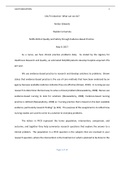CAUTI REDUCTION 1
CAUTI reduction: What can we do?
Amber Edwards
Walden University
NURS 4100-4 Quality and Safety through Evidence-Based Practice
May 9, 2017
As a nurse, we face clinical practice problems daily. As stated by the Agency for
Healthcare Research and Quality, an estimated 560,000 patients develop hospital-acquired UTIs
per year.
We use evidence-based practice to research and develop solutions to problems. Brown
states that evidence-based practice is the use of care methods that have been endorsed by an
agency because available evidence indicates they are effective (Brown, 2018). In nursing we use
research to determine the best way to solve a clinical problem (Nieswiadomy, 2008). Nurses use
evidence-based nursing to look for solutions (Nieswiadomy, 2008). Evidence-based nursing
practice is defined (Nieswiadomy, 2008) as “nursing practice that is based on the best available
evidence, particularly research finding” (p. 401). The purpose of this assignment is to reflect how
nursing studies are used to come to a solution to everyday problems.
The letters in PICO represent the terms population, intervention, comparison, and
outcome, and together they help summarize research questions that explore the answer to a
clinical problem. The population in a PICO question is the subjects that are involved in your
research question, where the intervention is the treatment or what is planned to be done to the
Page 1 of 19
,CAUTI REDUCTION 2
population to determine its effectiveness against the problem. Comparison is the control group
that you are comparing the intervention to that determines if you get the desired outcome that
represents and examines the effectiveness of the intervention (Brown, 2018). The PICO question
in this assignment is: Does removing urinary catheters less than 24 hours after placement reduce
the risk of developing catheter associated urinary tract infections (CAUTI’s) compared to having
urinary catheters in greater than 24 hours in hospitalized patients?
Catheters are used daily in healthcare settings. They are often used unnecessarily though
just for convenience of the medical staff. Urinary tract infections are the most common health
care associated infection, estimating at around 560,000 per year, with 387,550 of those being
preventable CAUTIs (Agency for Healthcare Research and Quality). The purpose of this paper is
to appraise multiple pieces of literature regarding the benefits and risks of catheter use and what
we can do to reduce CAUTIs.
I feel that the sooner a catheter is removed, the less chance of a CAUTI occurring. My
goal when starting this was to provide proof from studies performed showing this to be true. By
measuring the rate of CAUTIs occurring and the number of days the indwelling catheter was in
place, would help validate my statement.
The first study I chose, “A Review of Strategies to Decrease the Duration of Indwelling
Urethral Catheters and Potentially Reduce the Incidence of Catheter- Associated Urinary Tract
Infections”, was published in the Journal of Urologic Nurses. It qualifies as a systematic review.
The article focused on the duration and removal of catheters in comparison to CAUTI occurrence
(Bernard, Hunter, & Moore, 2012). An online database was used with specific keywords to narrow
the results. A total of 53 articles originated, but only 9 were used as the sample.
Page 2 of 19
, CAUTI REDUCTION 3
The study proved that nursing led interventions were successful in decreasing CAUTI
occurrence (Bernard, Hunter, & Moore, 2012). The length of time a catheter is in place is
concerned one of the greatest factor in getting a CAUTI (Bernard et al., 2012). More than one
study showed that by reducing the length of urinary catheter duration caused a decrease in the
incidence of CAUTI’s (Bernard, Hunter, & Moore, 2012). There was not enough evidence to prove
that this intervention reduced the occurrence more than any other interventions noted during
the study though. More evidence, from a larger sample, would be beneficial to effectively
determine the best intervention to use to reduce the rate of CAUTI’s in acute-care settings
(Bernard, Hunter, & Moore, 2012).
The second article titled, “Nurse-directed interventions to reduce catheter-associated
urinary tract infections”, goal was to develop and implement interventions to decrease the
amount of CAUTI incidence (Oman et al., 2012). It is always interesting to see the numbers on
paper: Nearly 25% of hospitalized patients are catheterized yearly, and 10% develop urinary tract
infections (Oman et al, 2012). Therefore, EBP guidelines are put in place, but the truth is, that
they are not always followed. A qualitative study was completed by performing a pre/post
intervention design. The sample design was unclear, but the article stated that they used one
hospital and the patients were on two separate units who had an indwelling urinary catheter
placed and they did not use any patients who had underdone urologic surgery. They performed
statistical tests on the data to determine the effectiveness of each intervention used to decrease
the rate of CAUTI occurrence. Only a few trained infection control nurses were used to collect
the data in order to preserve the validity of the data.
Page 3 of 19




